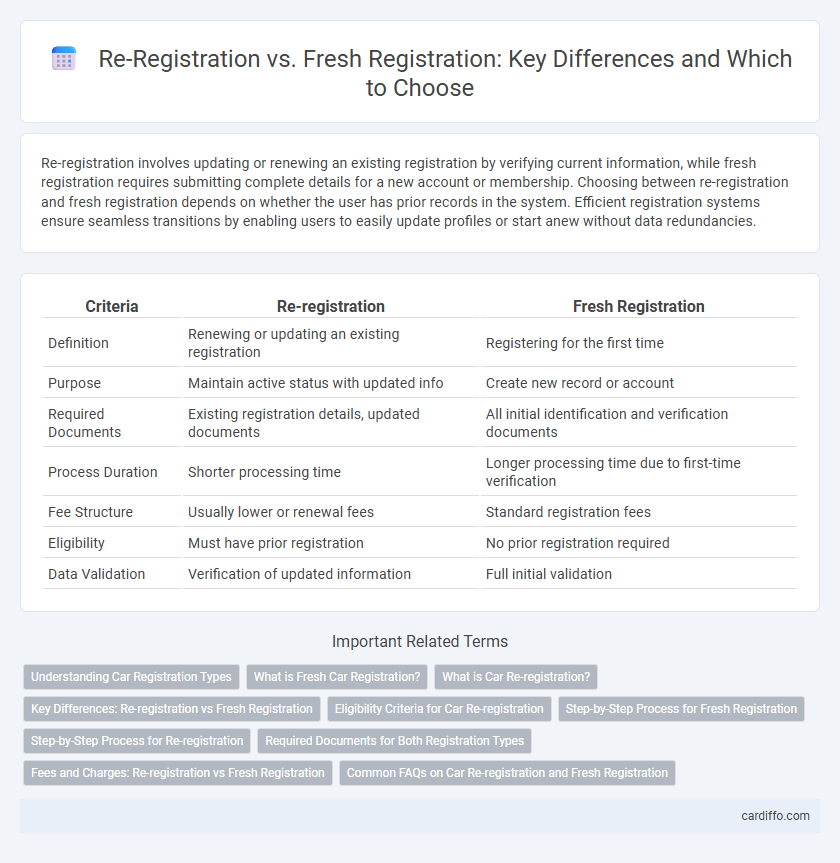Re-registration involves updating or renewing an existing registration by verifying current information, while fresh registration requires submitting complete details for a new account or membership. Choosing between re-registration and fresh registration depends on whether the user has prior records in the system. Efficient registration systems ensure seamless transitions by enabling users to easily update profiles or start anew without data redundancies.
Table of Comparison
| Criteria | Re-registration | Fresh Registration |
|---|---|---|
| Definition | Renewing or updating an existing registration | Registering for the first time |
| Purpose | Maintain active status with updated info | Create new record or account |
| Required Documents | Existing registration details, updated documents | All initial identification and verification documents |
| Process Duration | Shorter processing time | Longer processing time due to first-time verification |
| Fee Structure | Usually lower or renewal fees | Standard registration fees |
| Eligibility | Must have prior registration | No prior registration required |
| Data Validation | Verification of updated information | Full initial validation |
Understanding Car Registration Types
Re-registration involves updating or renewing existing vehicle registration details, often required after ownership transfer or change in vehicle status, whereas fresh registration applies to new vehicles entering the database for the first time. Fresh registration requires submission of original documents, such as purchase invoice and insurance, alongside compliance with emissions and safety standards. Vehicle owners should understand the distinctions to ensure compliance with local transportation authorities and avoid penalties.
What is Fresh Car Registration?
Fresh car registration refers to the initial process of registering a newly purchased vehicle with the relevant motor vehicle authority, establishing its legal status for road use. It involves submitting required documents such as proof of ownership, insurance, and compliance with emission and safety standards. Unlike re-registration, which renews or updates an existing registration, fresh registration sets up a unique vehicle identity number and registration certificate for the first time.
What is Car Re-registration?
Car re-registration involves updating the vehicle's registration details when ownership changes, relocation occurs, or significant modifications are made, ensuring the vehicle's legal compliance and accurate record-keeping. Unlike fresh registration, which applies to brand-new vehicles, re-registration requires submitting the original registration certificate along with proof of ownership transfer or address change. This process helps maintain up-to-date information in the motor vehicle department's database and facilitates lawful usage on public roads.
Key Differences: Re-registration vs Fresh Registration
Re-registration involves updating or renewing existing account details, often to maintain continued access without creating a new profile, while fresh registration requires users to create a new account from scratch. Key differences include the retention of previous data and credentials in re-registration compared to the initiation of new user information during fresh registration. Re-registration typically streamlines the process for returning users, whereas fresh registration targets first-time users requiring complete setup.
Eligibility Criteria for Car Re-registration
Car re-registration eligibility criteria require the vehicle to have a prior valid registration and no changes in ownership; fresh registration applies to newly purchased or imported vehicles without previous registration records. Re-registration typically mandates that the vehicle complies with current regulatory standards, including emissions and safety inspections, while fresh registration involves initial tax payment and plate issuance. Eligibility for re-registration excludes vehicles with expired or canceled registrations beyond a specified period, mandating renewal through fresh registration protocols.
Step-by-Step Process for Fresh Registration
Fresh registration requires gathering essential documents such as identity proof, address proof, and relevant application forms before initiating the process. Applicants must complete thorough verification and submission steps, including biometric data capture and fee payment, to confirm their registration. This step-by-step procedure ensures accurate data entry and successful creation of a new registration record, distinct from the re-registration process.
Step-by-Step Process for Re-registration
Re-registration involves updating or renewing existing registration details by following a clear step-by-step process: first, access the official registration portal and log in with your current credentials; second, review and update personal information, including any changes in address or contact details; finally, submit the updated information along with any required documents and confirmation fees to complete the re-registration. This process ensures continuity while reflecting current user data, differentiating it from fresh registration, which requires creating a completely new account and profile. Re-registration typically expedites access since existing user information is pre-filled, reducing errors and saving time.
Required Documents for Both Registration Types
Required documents for re-registration generally include a previous registration proof, identity proof, and updated address proof, ensuring continuity and verification of existing records. Fresh registration demands comprehensive documents such as identity proof, address proof, proof of business existence, and trade licenses, establishing a new entity's compliance. Both registration types may also require financial statements and tax-related documents depending on specific regulatory bodies and jurisdictional requirements.
Fees and Charges: Re-registration vs Fresh Registration
Re-registration fees are generally lower compared to fresh registration as they often involve updating existing records rather than creating new accounts. Fresh registration typically incurs higher initial charges due to the processing of new applicant data and verification steps. Fee structures for both processes vary by institution but re-registration offers cost benefits for returning users while fresh registration covers comprehensive administrative overheads.
Common FAQs on Car Re-registration and Fresh Registration
Car re-registration involves updating the ownership or details of an already registered vehicle, while fresh registration applies to brand-new vehicles entering the database for the first time. Common FAQs include requirements for documents, timelines for submission, fee differences, and procedures for transferring ownership during re-registration. Understanding these distinctions helps car owners comply with legal obligations and avoid penalties.
Re-registration vs Fresh Registration Infographic

 cardiffo.com
cardiffo.com